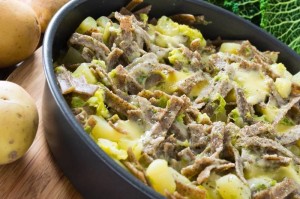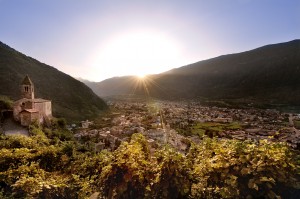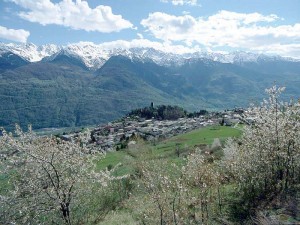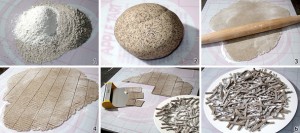Pizzoccheri Pizzoccheri
Secondo il Sertoli Salis il termine pizzoccheri, il cui nome costituirebbe l’equivalente di pinzocheri, indicherebbe “persone bacchettone”, di poco conto. Più che di modestia si tratta certamente di una certa inclinazione all’uso di nomi scherzosi come lo è ad esempio il termine sciatt, che per l’originaria forma sgraziata di queste frittelle di grano saraceno, sta ad indicare, nel dialetto locale, i rospi. Ma da quando i tellini mangiano questi gustosissimi pizzoccheri?
Secondo Giuseppe Baretta, ricercatore della Biblioteca Nazionale Braidense, i “PINZOCHERI, oggi chiamati pizzoccheri fatti con il grano saraceno già si gustavano ai tempi della Meluzza, che fu l’inventrice, una donna che di cucina la sapeva lunga.
I comaschi non erano solo la gente di Como e d’intorni, ma dir comaschi voleva dire tutta la popolazione del lago fin su la Valtellina, dove si estendeva la diocesi comasca.
Il grano saraceno veniva dunque usato nella cucina già dal secolo XIV, assieme agli altri cereali: miglio, orzo, panico, avena.
La Meluzza diede a questo cereale più gusto aggiungendovi cacio, burro, verdure. Oltre ai pizzoccheri ecco la polenta taragna fatta anch’essa con il grano saraceno, senz’altro ancor prima dei pizzoccheri. Patria dei pizzoccheri l’alta Valtellina, con capitale Teglio.”
La storia testimonia infatti che nel 1192 l’imperatore Enrico VI impose a Teglio l’ubbidienza alla ghibellina Como. I secoli che succeddettero, sino ad arrivare al trattato di Alleanza con i Grigioni nel 1512, furono un susseguirsi di domini: ora i guelfi di Milano, ora i ghibellini comaschi. Ricordiamo che ancora oggi la Valtellina è sotto l’arcivescovado di Como. Altra notizia storica da non sottovalutare è naturalmente la visita di Ortensio Lando presso la famiglia Besta di Teglio nel 1500. Si suppone quindi che in quella occasione degustò i famosi pizzoccheri di Teglio.
Nell’approfondito studio effettuato dalla Professoressa Nella Credaro Porta (Mondo Popolare in Sondrio, Lombardia, e il suo Territorio) troviamo numerosi altri documenti che fanno riferimento a questa pietanza.

Nel 1798 nella opera di Lehmann “Die Republik Graubunden”, che quindi riguarda l’area dei Grigioni, di cui la Valtellina era parte, con un preciso riferimento alla Ns zona troviamo:
(…) il contadino benestante vive bene. Consuma infatti i prodotti della sua terra. Latte, formaggio e burro sono serviti ogni giorno in abbondanza.
La polenta, il Malonz , la zuppa di formaggio, i Perzockel, la Minestra e il Tasch sono i suoi piatti preferiti per il giorno di magro.(…) I “Perzockel” sono una sorta di tagliatelle fatte di farina e di due uova.
La pasta vien cotta nell’acqua, poi si aggiunge il burro e si sparge subito il formaggio grattato.(…)
Anche nella seconda metà dell’800 vi son testi che parlano dei pizzoccheri:
(…) Vi si fa gran d’uso di farinacei e di certe paste grossolane che si cospergono con butirro e formaggio a guisa di tagliatelli, dette Pizzoccheri, delle quali vanno assai ghiotti i Sondriesi (…)
Le notizie più precise relative ai Pizzoccheri di Teglio le riscontriamo nel 1889 con Bartolommeo Besta, medico condotto tellino, attraverso il suo manoscritto “la inchiesta Jacini” (Inchiesta agraria e sulle condizioni della classe agricola nel 1882).
Attraverso la sua testimonianza, perciò, possiamo individuare un modello di alimentazione dei produttori agricoli delle nostre valli. Sistema di approvigionamento che è basato sull’autoconsumo dei propri prodotti. Secondo il Besta i 3 piatti che come ingrediente base avevano il grano saraceno erano:
(…) “Tagliatelli, detti Pizzoccheri, bolliti nell’acqua e poi conditi asciutti con buona dose di cacio e di burro, la polenta taragnia e gli sciatt o chiscioi” (…)
Queste venivano inoltre considerate delle speciali pietanze.
Sempre secondo la Professoressa Nella Credaro Porta “I PIZZOCCHERI sono stati e sono il piatto più importante della zona che va da Grosio a Castione, con epicentro a Teglio, ed era anche un piatto non dei contadini più poveri, in quanto presupponeva la lavorazione su un tavolo, che non sempre esisteva nelle case modeste. Si tratta di tagliatelle grossolane di farina bianca e di grano saraceno in parti che variano a seconda dei paesi. Cotti in abbondante acqua salata in cui sono poste patate o verze e/o coste a pezzi, i pizzoccheri vengono scolati con il mestolo bucato e conditi a strati con il formaggio semigrasso a fette, formaggio di grana e sopra burro abbondante fitto ben scuro con aglio (…)”
I contadini più poveri, per ovviare all’ inconveniente di non possedere il tavolo per tirare la sfoglia, preparavano la pasta come per i pizzoccheri, ne prendevano tra le mani dei pezzettini e davano la forma di gnocchetti con il cucchiaio e quindi li cuocevano e condivano come i pizzoccheri.
Ingredienti (dosi per 4 persone)
400 g di farina di grano saraceno
100 g di farina bianca
200 g di burro
250 g di formaggio Valtellina Casera dop
150 g di formaggio in grana da grattugia
200 g di verze
250 g di patate
uno spicchio di aglio, pepe

Preparazione:
Mescolare le due farine, impastarle con acqua e lavorare per circa 5 minuti.
Con il mattarello tirare la sfoglia fino ad uno spessore di 2-3 millimetri dalla quale si ricavano delle fasce di 7-8 centimetri. Sovrapporre le fasce e tagliarle nel senso della larghezza, ottenendo delle tagliatelle larghe circa 5 millimetri.
Cuocere le verdure in acqua salata, le verze a piccoli pezzi e le patate a tocchetti, unire i pizzoccheri dopo 5 minuti (le patate sono sempre presenti, mentre le verze possono essere sostituite, a secondo delle stagioni, con coste o fagiolini).
Dopo una decina di minuti raccogliere i pizzocheri con la schiumarola e versarne una parte in una teglia ben calda, cospargere con formaggio di grana grattugiato e Valtellina Casera dop a scaglie, proseguire alternando pizzoccheri e formaggio.
Friggere il burro con l’aglio lasciandolo colorire per bene, prima di versarlo sui pizzoccheri.
Senza mescolare servire i pizzoccheri bollenti con una spruzzata di pepe.According to the Sertoli Salis the term pizzoccheri, whose name would be the equivalent of Pinzocheri, indicate “bigoted people”, unimportant. More than modesty is certainly a certain inclination to the use of playful names such as it is the term sciatt, that for the original form of these ungainly buckwheat pancakes, denotes, in the local dialect, toads . But since the tellini eat these tasty pizzoccheri?
According to Giuseppe Barretta, a researcher of the Braidense National Library the “PINZOCHERI, today called pizzoccheri, made with buckwheat was already tasted at the time of Meluzza, who was the inventor, a woman who knew a lot of cooking. The comaschi were not only the people of Como and the surrounding area, but saying the comaschi meant the entire population of the lake from the Valtellina, where the Diocese of Como was extended.
Buckwheat was therefore used in the kitchen since the fourteenth century, along with other cereals: millet, barley, foxtail millet, oats. The Meluzza gave this cereal taste by adding more cheese, butter, vegetables.
In addition to pizzoccheri here it is the polenta taragna also made with buckwheat, certainly before the pizzoccheri. Homeland of pizzoccheri is the Alta Valtellina, with capital Teglio.”
The history testifies to that in 1192 the Emperor Henry VI imposed in Teglio the obedience to the ghibelline Como. The followed centuries, until you get to the Treaty of Alliance with the Grisons in 1512, were a series of domains: now the Guelphs of Milan, now the Ghibellines of Como. Remember that even today the Valtellina is under the archbishopric of Como. Another historical news to be reckoned with is of course the visit of Hortensius Lando at Besta family in Teglio in 1500. It is assumed then that on that occasion he tasted the famous pizzoccheri of Teglio. In detailed study carried out by Professor Nella Credaro Porta (Popular World in Sondrio, Lombardia, and its Territory) we find numerous other documents that refer to this dish.

In 1798 the work of Lehmann “Die Republik Graubunden”, which then covers the area of Grisons, which was part of the Valtellina, with a specific reference to Teglio area we find:
(…) The prosperous farmer live well. Consumes infact the products of his land. Milk, cheese and butter are served daily in abundance. Polenta, Malonz, cheese soup, the Perzockel, the soup and the Tasch are his favorite dishes for meatless day. (…) The “Perzockel” are a kind of noodles made of flour and two eggs. The pasta comes cooked in water, then add the butter and spreads quickly grated cheese. (…)
Even in the second half of the 800, there are texts that speak of pizzoccheri:
(…) It will make great use of flour and some coarse pastas which are sprinkled with butter and cheese like noodles, called pizzoccheri, which the Sondriesi are very gluttons (…)
More precise information regarding the Pizzoccheri of Teglio we find in 1889 with Bartolomeo Besta, a local doctor, through his manuscript “the Jacini investigation” (Agrarian Investigation about the conditions of the agricultural class in 1882). Through his testimony, therefore, we can find a feed model of agricultural producers of this valleys. Procurement system that is based on self-sufficiency of its products. According to the Besta the 3 dishes that had as basic ingredient the buckwheat were:
(…) “Tagliatelli, called pizzoccheri, boiled in water and then seasoned with a good dose of dry cheese and butter, the polenta taragnia and the sciatt or chiscioi” (…) These were also considered special dishes.
Always according to Professor Nella Credaro Porta “The PIZZOCCHERI were and are the most important dish of the area stretching from Grosio to Castione, with its epicenter in Teglio, and it was not even a plate of the poorest farmers, because it presupposed to be processed on a table, which does not always exist in modest houses. It is coarse white flour and buckwheat noodles into parts that vary by villages. Cooked in salted water in which are placed potatoes or cabbage and/or swiss chard into pieces, the pizzoccheri are drained with the slotted spoon and dressed in layers with fat cheese slices, cheese grits and coverd with abudant butter fried well dark with garlic (…) ”
The poorest farmers, to obviate the problem of not owning the table for rolling dough, preparing the pasta as if to the pizzoccheri, they took in their hands small pieces and gave the form of gnocchi with a spoon and then cooked and seasoned them as the pizzoccheri.
Ingredients (serves 4)
400 g of buckwheat flour
100 g of white flour
200 g of butter
250 g of cheese Valtellina Casera DOP
150 g of grated Parmesan cheese
200 g of cabbage
250 g of potatoes
a clove of garlic, pepper

Preparation:
Mix the flours, mix with water and work for about 5 minutes.
With a rolling pin roll the dough to a thickness of 2.3 millimeters, cut in strips of 7-8 centimeters. Overlap the strips and cut widthwise, getting noodles width of about 5 mm.
Cook the vegetables in salted water, the cabbage into small pieces and the potatoes into chunks, add the pizzoccheri after 5 minutes (the potatoes are always present, while the cabbage can be replaced, according to the seasons, with swiss chards or green beans). After ten minutes collect pizzoccheri with a slotted spoon and pour a part in a very hot pan, sprinkle with grated Parmesan cheese and Valtellina Casera DOP slices, proceed alternating pizzoccheri and cheese. Fry the butter with the garlic leaving browning well, before pouring on pizzoccheri. Serve the pizzoccheri very hot, without stirring, with a sprinkling of black pepper.








Leave a comment